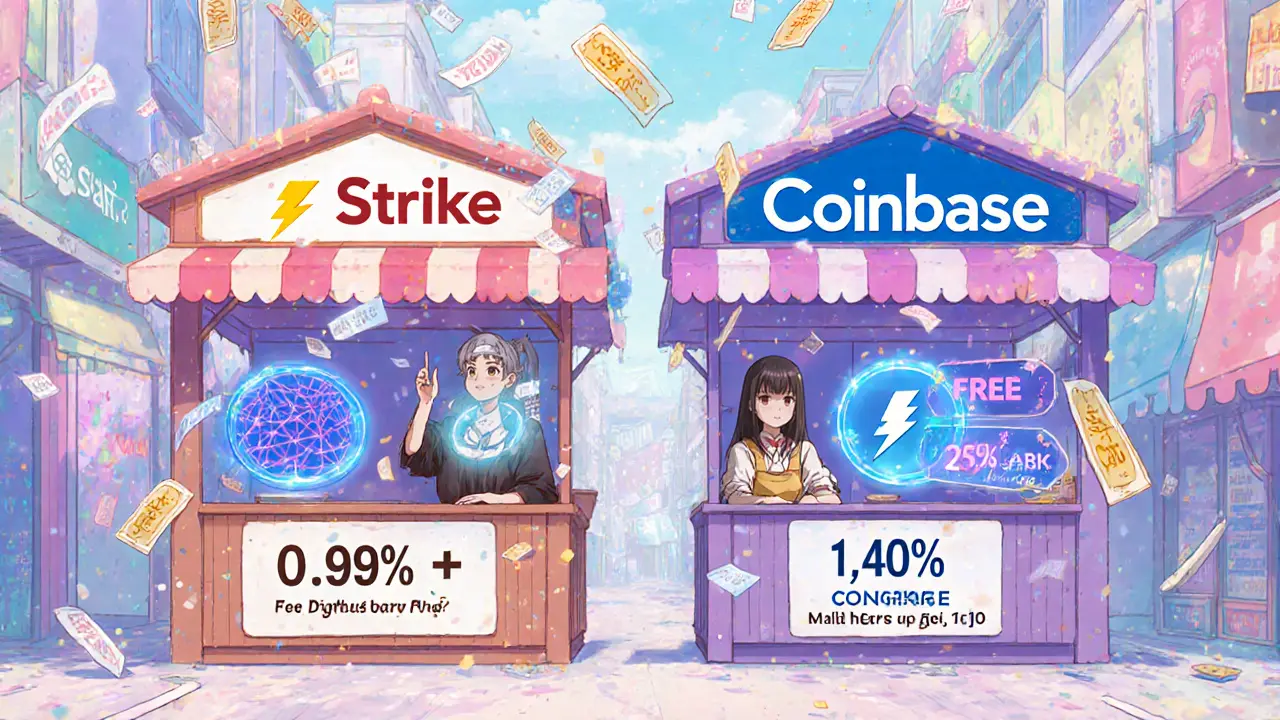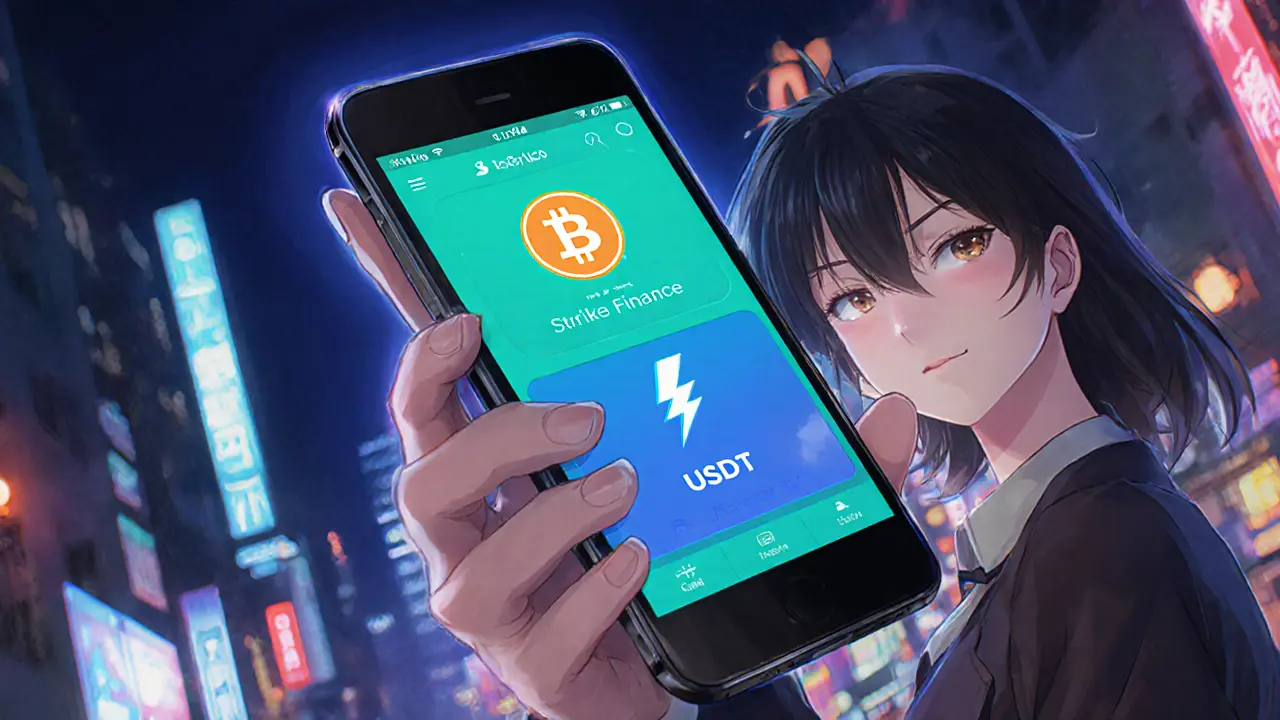Strike Finance Fee Calculator
Estimated Monthly Trading Fees
| Feature | Strike Finance | Coinbase |
|---|---|---|
| Supported assets | BTC, USDT | 240+ cryptocurrencies |
| Base trading fee | 0.99% ($250 volume) | 1.49% (US retail) |
| Card purchase fee | 2%-4% | 3%-4% |
| Cross-border transfer fee | Free (Lightning) or network fee | Up to 1% |
| Withdrawal fee | Only Bitcoin network fee | Variable, often $0.99-$1.99 |
When it comes to fast Bitcoin payments, Strike Finance is a payments app and limited crypto exchange built by Zap Solutions. Founded by Jack Mallers, Strike combines traditional money‑transfer flows with Bitcoin’s on‑chain and Lightning Network capabilities, aiming to make cross‑border payments cheap and instant.
What Strike Actually Offers
Unlike generic exchanges that list hundreds of tokens, Strike focuses on two assets: Bitcoin (BTC) and USDT. Users can buy, sell, or hold either asset, set up automatic Dollar Cost Averaging (DCA) purchases, and send money globally in seconds. The “Send Globally” feature works in more than a dozen countries and leverages the Lightning Network for micro‑transactions that settle virtually instantly.
Fee Structure Compared to the Competition
Strike’s tiered trading fees start at 0.99% for monthly volumes under $250 and drop as you trade more. Debit or credit card purchases carry a 2%-4% surcharge, while standard peer‑to‑peer payments are free apart from the minimal Bitcoin network fee you set yourself. By contrast, major rivals such as Coinbase charge roughly 1.49% for US users and add higher spreads for crypto‑to‑crypto trades. The table below highlights the key cost differences.
| Feature | Strike Finance | Coinbase |
|---|---|---|
| Supported assets | BTC, USDT | 240+ cryptocurrencies |
| Base trading fee | 0.99% (‑$250 volume) | 1.49% (US retail) |
| Card purchase fee | 2%-4% | 3%-4% |
| Cross‑border transfer fee | Free (Lightning) or network fee | Up to 1% |
| Withdrawal fee | Only Bitcoin network fee | Variable, often $0.99‑$1.99 |
Key Features That Set Strike Apart
- Lightning Network integration: Enables near‑instant micro‑payments with negligible fees.
- Automatic DCA with no extra charge - ideal for beginners who want to build a BTC position over time.
- Limit orders for BTC/USDT, a rarity among payment‑first apps.
- Bitcoin bill‑pay: You can pay utilities or rent directly from your BTC balance.
- Payroll and salary‑in‑BTC options for freelancers and remote teams.
- Bitcoin‑backed loans in select U.S. states, allowing cash access without selling holdings.

Security and Custody Model
Strike operates a 1:1 custodial model: every dollar and every satoshi you deposit is held on your behalf, not pooled with other users. The platform partners with Plaid for secure bank‑account linking and employs verification‑level limits on deposits, withdrawals, and transfers. Bitcoin withdrawals are subject to the standard Bitcoin network security, and users can choose between three fee‑speed options - Priority, Standard, or Flexible - to control how fast their on‑chain transaction confirms.
Who Benefits Most From Strike?
The sweet spot includes freelancers getting paid from overseas clients, small businesses that need cheap international payroll, and users in emerging markets where Bitcoin is used for financial inclusion (e.g., ElSalvador, Argentina, Philippines). Because the app removes the need to learn wallets, private keys, or exchange order books, it’s a solid entry point for newcomers who just want to buy Bitcoin and send it instantly.
Drawbacks to Keep in Mind
Strike’s narrow asset list means you can’t diversify into DeFi tokens, NFTs, or altcoins. Active traders miss features like futures, margin, or deep liquidity pools. Also, the custodial nature requires you to trust Zap Solutions with your funds - there’s no non‑custodial private‑key control. Finally, while Lightning makes micro‑payments cheap, large on‑chain withdrawals still incur Bitcoin network fees that can spike during congestion.

How Strike Stacks Up Against Other Platforms
When you compare Strike to CashApp’s Bitcoin feature, PayPal’s crypto offering, and Coinbase’s consumer app, three themes emerge:
- Speed: Only Strike’s Lightning integration consistently delivers sub‑second settlement for everyday amounts.
- Cost: Fees are generally lower for cross‑border transfers, especially when you stay within the Lightning ecosystem.
- Scope: Strike sacrifices breadth - you get Bitcoin plus USDT, nothing else. If you need a full‑service exchange, Coinbase remains the go‑to.
Overall, Strike shines as a Bitcoin‑first payment processor, not as an all‑in‑one crypto broker.
Bottom Line - Is Strike Right for You?
If your primary goal is to move Bitcoin quickly, pay bills with crypto, or accumulate BTC without wrestling with complex UI, Strike is a strong contender. For users who want diversified portfolios, advanced trading tools, or non‑custodial control, you’ll probably look elsewhere.
Frequently Asked Questions
Can I withdraw Bitcoin to an external wallet?
Yes. Strike lets you send BTC to any external address. The transaction uses the Bitcoin network fee you select (Priority, Standard, or Flexible) and is not limited by the Lightning Network.
Is Strike available in the United States?
Strike operates in over 65 countries, including the U.S. However, certain features - like Bitcoin‑backed loans - are only available in select U.S. states due to regulatory constraints.
How does the Lightning Network improve my experience?
Lightning creates off‑chain payment channels that settle instantly and cost pennies, making it perfect for everyday transfers, micro‑payments, and paying merchants who accept BTC.
What security measures protect my funds?
Strike stores assets in a 1:1 custodial model, uses industry‑standard encryption, partners with Plaid for bank linking, and follows Bitcoin’s robust network security for on‑chain withdrawals.
Can I set up automatic Bitcoin purchases?
Yes, Strike’s DCA feature lets you schedule recurring BTC buys with no extra fees, helping you average into the market over time.







Comments
Carthach Ó Maonaigh
September 11, 2025 AT 05:42 AMYo the fee table is a joke, Strike’s 0.99% is a laugh when you compare it to the hidden spreads they hide.
Cathy Ruff
September 12, 2025 AT 05:45 AMStrike thinks it’s the holy grail of crypto payments but it’s just another overpriced middleman we don’t need
Greer Pitts
September 13, 2025 AT 05:49 AMI get why folks love the instant Lightning stuff it’s super handy and makes sending cash feel like a breeze.
Jenise Williams-Green
September 14, 2025 AT 05:52 AMWhile many hail Strike as a saviour for cross‑border remittances, the stark reality is that its two‑asset restriction shackles any genuine diversification, rendering it a gilded cage for the uninformed.
Rob Watts
September 15, 2025 AT 05:55 AMIf you’re after cheap transfers just use the Lightning option it’s fast and the fees are practically zero
mukesh chy
September 16, 2025 AT 05:59 AMSure because paying a few percent on a card is the pinnacle of financial innovation right
Marc Addington
September 17, 2025 AT 06:02 AMAmerican users deserve a home‑grown solution, not a foreign app eating our dollars.
Amal Al.
September 18, 2025 AT 06:05 AMIndeed, the limitation to BTC and USDT does simplify the user experience, yet it also curtails exposure to the broader crypto ecosystem; consequently, potential investors may feel confined.
Natalie Rawley
September 19, 2025 AT 06:09 AMOMG the whole thing is like watching a reality TV drama where the protagonist thinks they’re revolutionary but they’re just another puppet!
Scott McReynolds
September 20, 2025 AT 06:12 AMWhen you first stumble upon Strike’s sleek interface, the promise of instant, borderless Bitcoin payments feels like stepping into a utopian future where friction evaporates.
Yet, beneath that glossy veneer lies a series of trade‑offs that merit careful contemplation.
The platform’s custodial model, while convenient, concentrates trust in a single entity, echoing age‑old concerns about centralization in a space that cherishes decentralization.
Moreover, the restriction to only BTC and USDT narrows the investment horizon, effectively sidelining the vibrant ecosystem of altcoins, DeFi tokens, and NFTs that many users seek.
For freelancers receiving cross‑border payments, the Lightning‑powered micro‑transactions are undeniably attractive, slashing fees to pennies and delivering near‑instant settlement.
Contrast this with traditional banking pipelines that can take days and charge percentages that erode earnings.
Alex Gatti
September 21, 2025 AT 06:15 AMI see the point but the simplicity might actually alienate power users
John Corey Turner
September 22, 2025 AT 06:19 AMThe dialectic between convenience and sovereignty in platforms like Strike mirrors the age‑old tug‑of‑war between the bardic lyric of freedom and the corporate chorus of control, a symphony that resonates across the blockchain.
Katherine Sparks
September 23, 2025 AT 06:22 AMDear esteemed community, I wish to convey my sincere appreciation for the comprehensive analysis presented herein; it elucidates the nuanced interplay of fee structures and user experience with commendable clarity. 😊
Kimberly Kempken
September 24, 2025 AT 06:25 AMYour poetic babble obscures the fact that Strike is just another cash‑grabber exploiting naïve users; wake up.
Ciaran Byrne
September 25, 2025 AT 06:29 AMGood summary, but missing the risk of custodial exposure.
Brooklyn O'Neill
September 26, 2025 AT 06:32 AMIndeed, custodial models do introduce counter‑party risk; users should weigh that against the convenience offered.